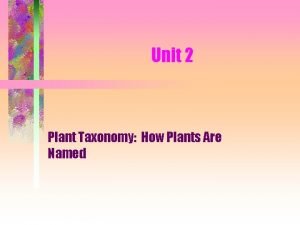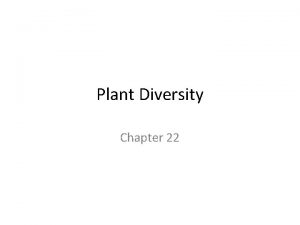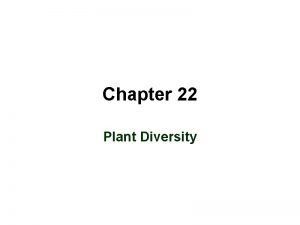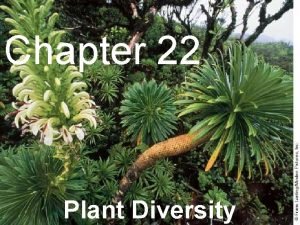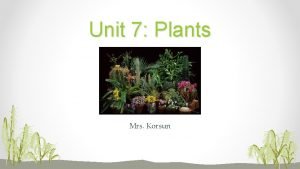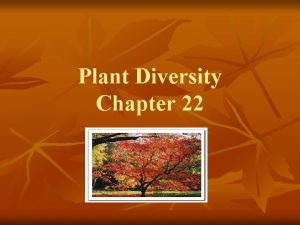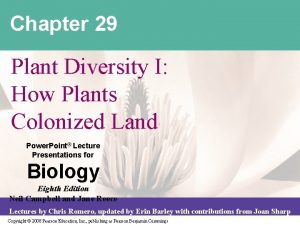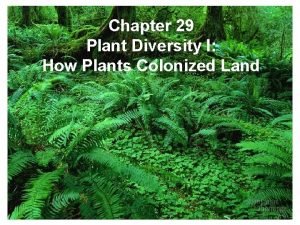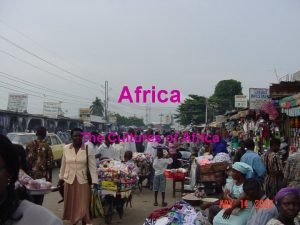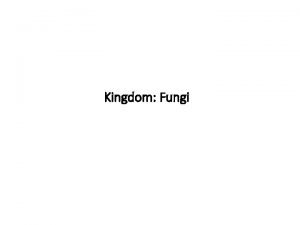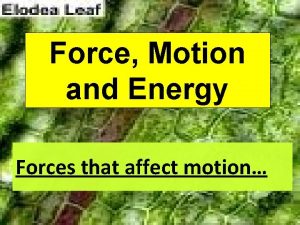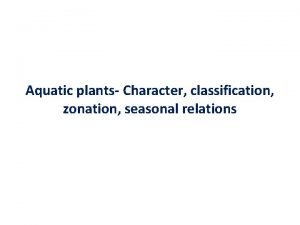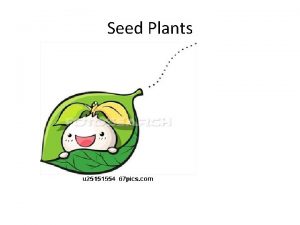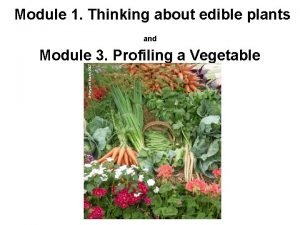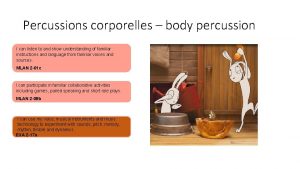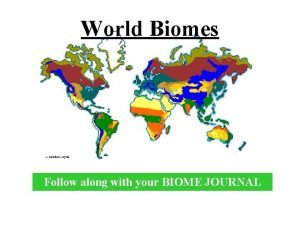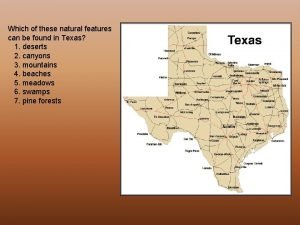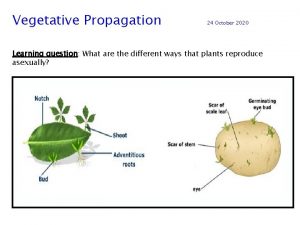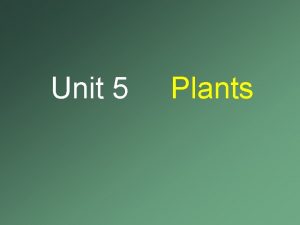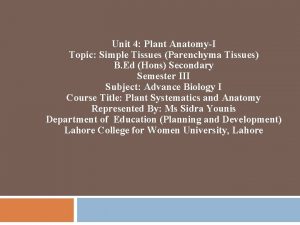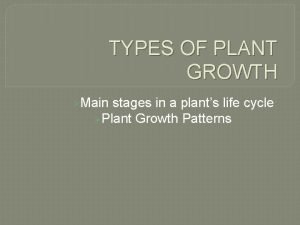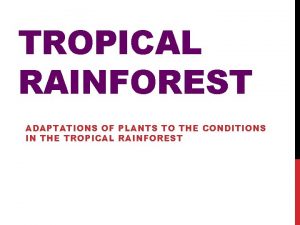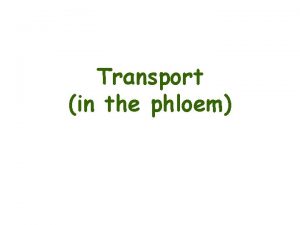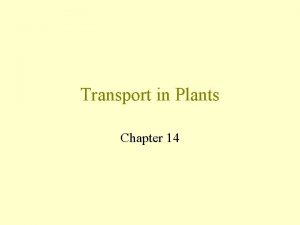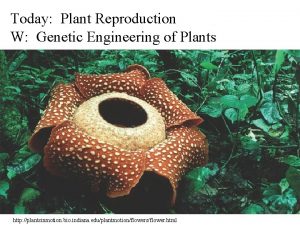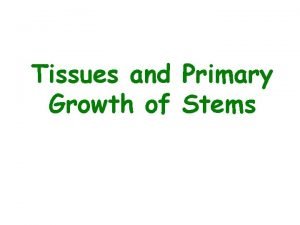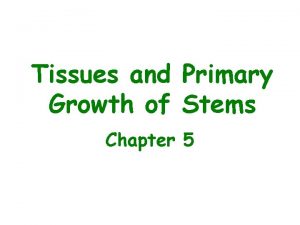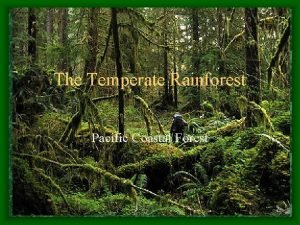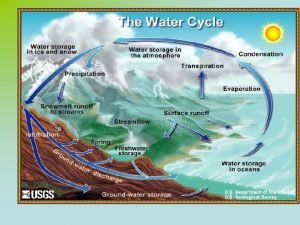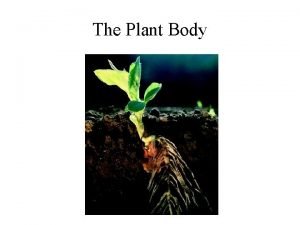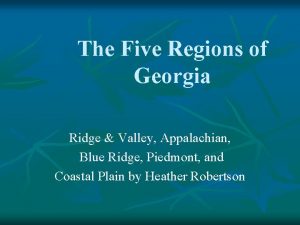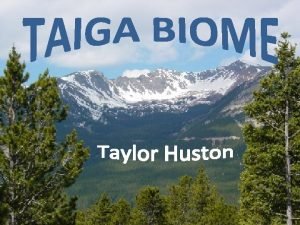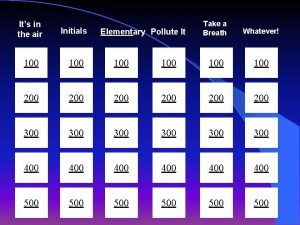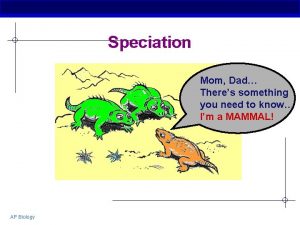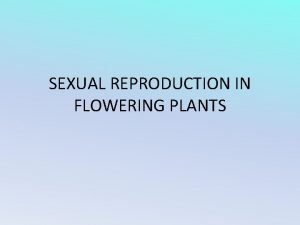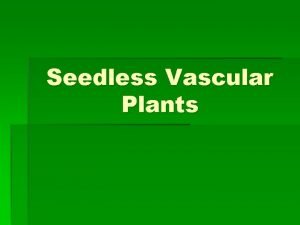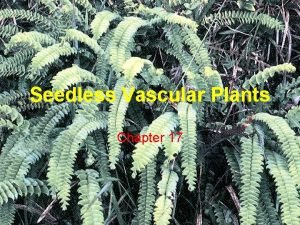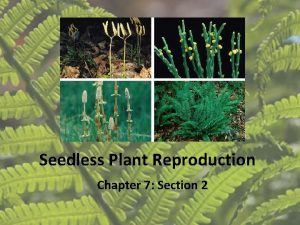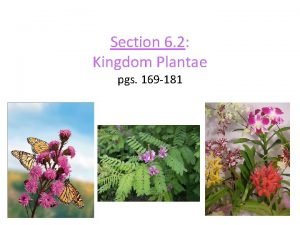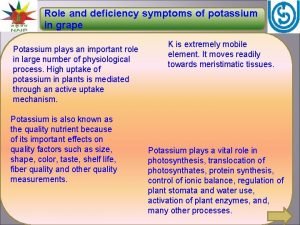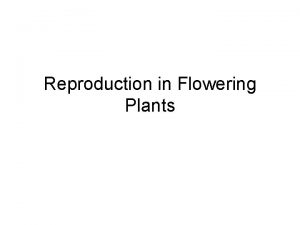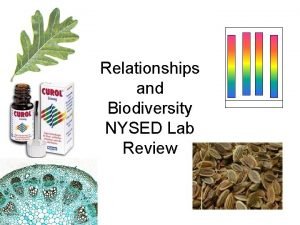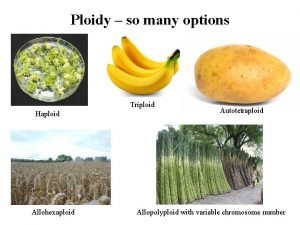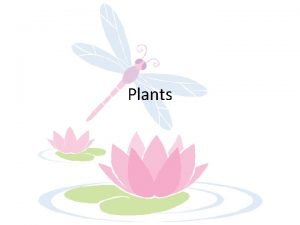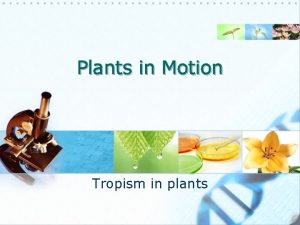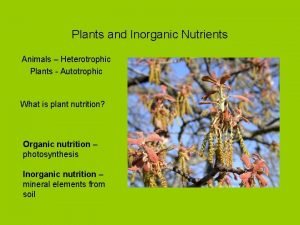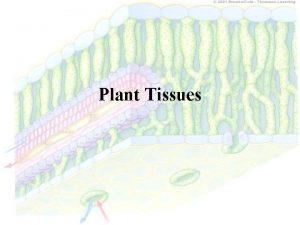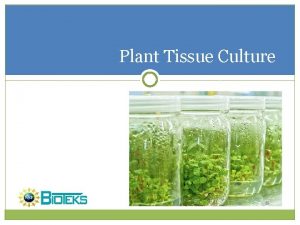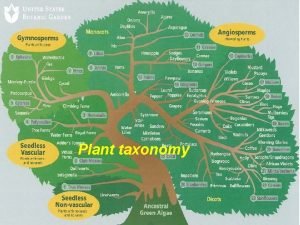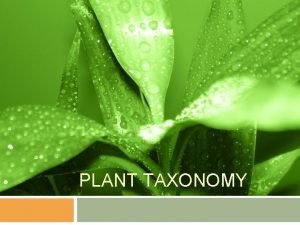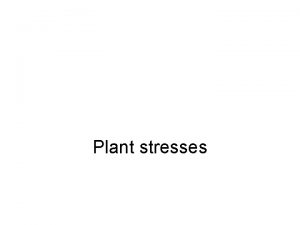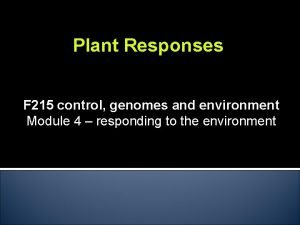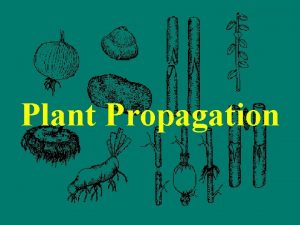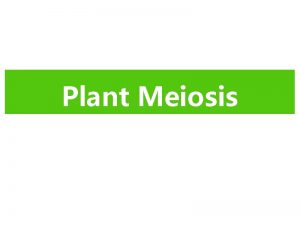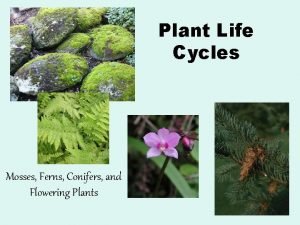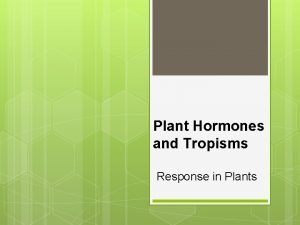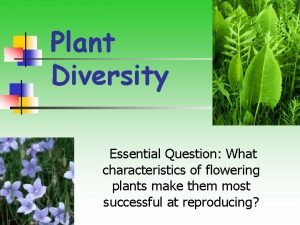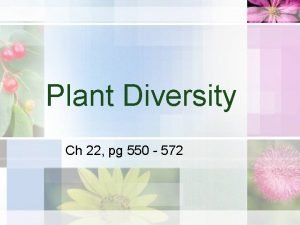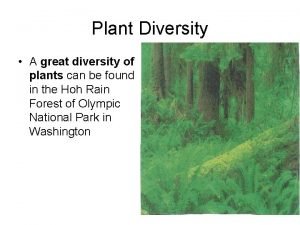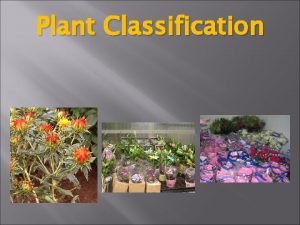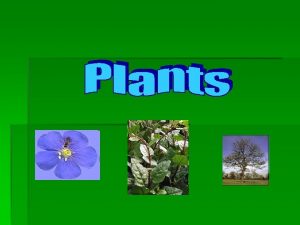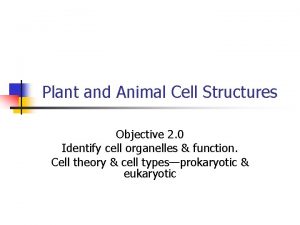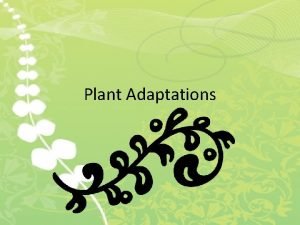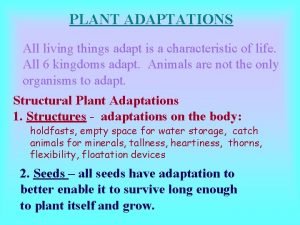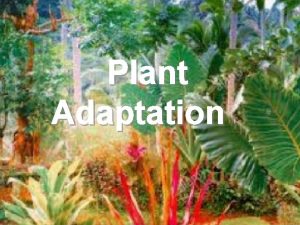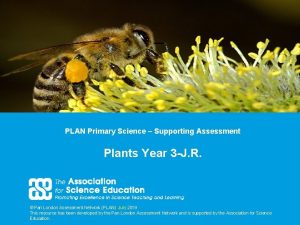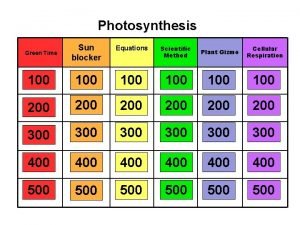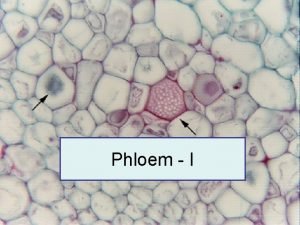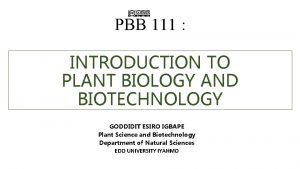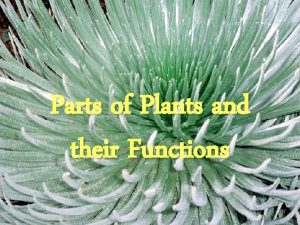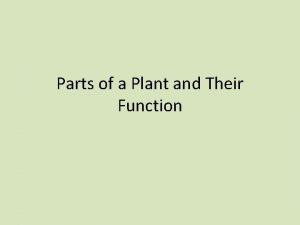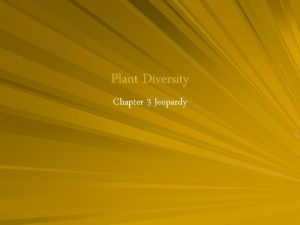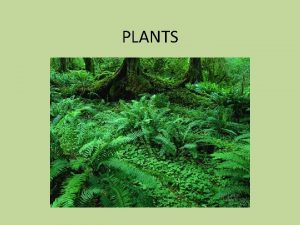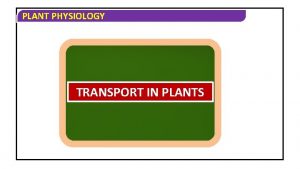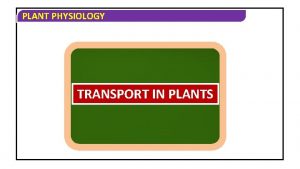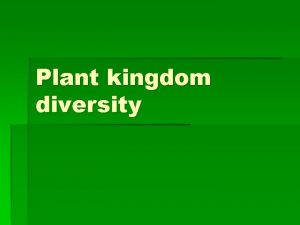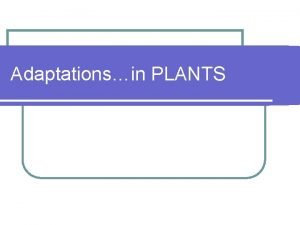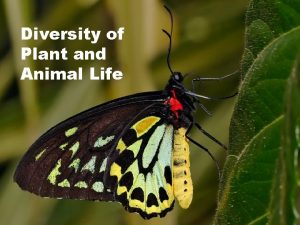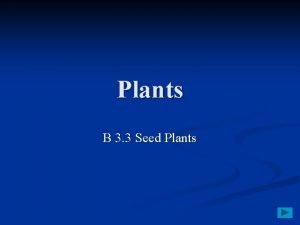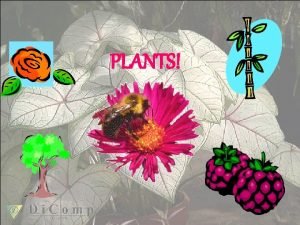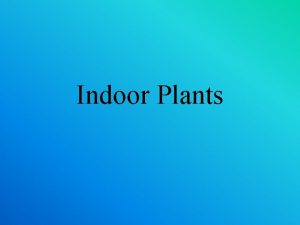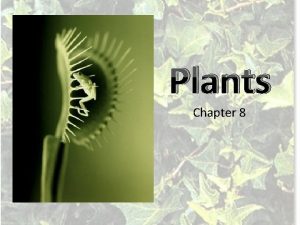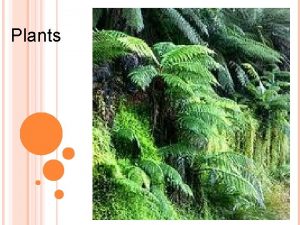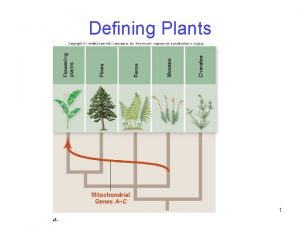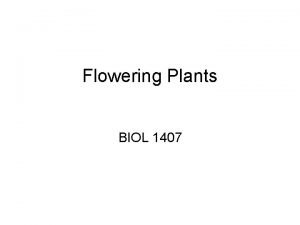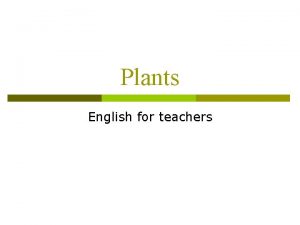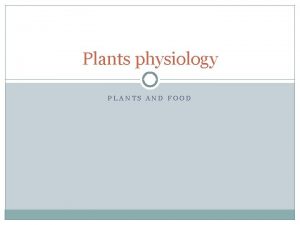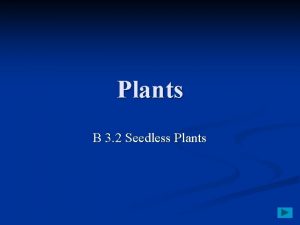Plant Diversity A great diversity of plants can









































































































































- Slides: 137

Plant Diversity • A great diversity of plants can be found in the Hoh Rain Forest of Olympic National Park in Washington

Plant Diversity

Introduction to Plants • What color is life? • That's a silly question, of course, because living things can be just about any color • But consider it in a different way • Imagine yourself in a place on Earth where the sounds and scents of life are all around you • The place is so abundant with life that when you stand on the ground, living things blot out the sun • Now, what color do you see? • If you have imagined a thick forest or a teeming jungle, then one color will fill the landscape of your mind—green—the color of plants

Introduction to Plants • Plants dominate the landscape • Where plants are plentiful, other organisms, such as animals, fungi, and microorganisms, take hold and thrive • Plants provide the base for food chains on land • They also provide shade, shelter, and oxygen for animals of every size and kind • The oldest fossil evidence of plants dates from about 470 million years ago • Since then, plants have colonized and transformed nearly every corner of Earth

What Is a Plant? • Plants are members of the kingdom Plantae • Plants are multicellular eukaryotes that have cell walls made of cellulose • They develop from multicellular embryos and carry out photosynthesis using the green pigments chlorophyll a and b • Plants include trees, shrubs, and grasses, as well as other organisms, such as mosses and ferns • Most plants are autotrophs, although a few are parasites or saprobes that live on decaying materials

What Is a Plant? • Plants are so different from animals that sometimes there is a tendency to think of them as not being alive • With few exceptions, plants do not gather food nor do they move about or struggle directly with their predators • Plants can neither run away from danger nor strike blows against an adversary • But as different as they are from animals, plants are everywhere • How have they managed to be so successful?

What Is a Plant? • That question has many answers • In the next few chapters, we will explore some of them • For now, it might help to think of plants as a well-known botanist once described them—as “stationary animals that eat sunlight”!

PLANT KINGDOM • Eukaryotic organisms that manufacture their own food by photosynthesis (autotrophic) • Range in size from single cell to multicellular organisms (redwoods) • Contain chlorophyll in chloroplast • Store food as starch • Cell walls contain cellulose • Most are nonmotile

ADAPTATION TO LAND • Evolved from the green algae of the Division Chlorophyta that lived in the ancient oceans or ponds • Cuticle: – Waxy covering that prevents desiccation • Multicellular gametangia: protect gametes (sperm and egg) from desiccation during development • Specialized structures from absorbing water from soil and anchoring the plant • Vascular tissue: transportation of water and food from one part of a plant to another

The Plant Life Cycle • Plant life cycles have two alternating phases, a diploid (2 N) phase and a haploid (N) phase, known as alternation of generations • During the two phases of the life cycle, shown in the figure, mitosis and meiosis alternate to produce the two types of reproductive cells—gametes and spores • The diploid (2 N) phase is known as the sporophyte, or sporeproducing plant • The haploid (N) phase is known as the gametophyte, or gameteproducing plant • Plant spores are haploid (N) reproductive cells formed in the sporophyte plant by meiosis that can grow into new individuals – The new individual is the gametophyte • A gamete is a reproductive cell that is produced by mitosis and fuses during fertilization with another gamete to produce a new individual, the diploid sporophyte

The Plant Life Cycle • All plants have a life cycle with alternation of generations, in which the haploid gametophyte phase alternates with the diploid sporophyte phase

The Plant Life Cycle

The Plant Life Cycle • The earliest plants, mosses and ferns, require water to reproduce • Seed plants, which appeared more recently, have reproductive cycles that can be carried out without water • Many plants also have forms of vegetative, or asexual, reproduction

What Plants Need to Survive • Surviving as stationary organisms on land is a difficult task, but plants have developed a number of adaptations that enable them to succeed • The lives of plants center on the need for sunlight, water and minerals, gas exchange, and the transport of water and nutrients throughout the plant body

Sunlight • Plants use the energy from sunlight to carry out photosynthesis • As a result, every plant displays adaptations shaped by the need to gather sunlight • Photosynthetic organs such as leaves are typically broad and flat and are arranged on the stem so as to maximize light absorption

Water and Minerals • All cells require a constant supply of water • For this reason, plants must obtain and deliver water to all their cells—even those that grow aboveground in the dry air • Water is one of the raw materials of photosynthesis, so it is used up quickly when the sun is shining • Sunny conditions, such as those in a desert, can cause living tissues to dry out • Thus, plants have developed structures that limit water loss • As they absorb water, plants also absorb minerals • Minerals are nutrients in the soil that are needed for plant growth

Gas Exchange • Plants require oxygen to support cellular respiration as well as carbon dioxide to carry out photosynthesis • They must exchange these gases with the atmosphere without losing excessive amounts of water through evaporation

Movement of Water and Nutrients • Plants take up water and minerals through their roots but make food in their leaves • Most plants have specialized tissues that carry water and nutrients upward from the soil and distribute the products of photosynthesis throughout the plant body • Simpler types of plants carry out these functions by diffusion

Early Plants • For most of Earth's history, plants did not exist – Life was concentrated in oceans, lakes, and streams • Algae and photosynthetic prokaryotes added the oxygen to our planet's atmosphere and provided food for animals and microorganisms

Early Plants • When plants appeared, much of the existing life on Earth changed • As these new photosynthetic organisms colonized the land, they changed the environment in ways that made it possible for other organisms to develop • New ecosystems emerged, and organic matter began to form soil • How did plants adapt to the conditions of life on land? • How plants evolved structures that acquire, transport, and conserve water is the key to answering this question

Origins in the Water • You may recall from Chapter 20 that green algae are photosynthetic, plantlike protists – Many of these algae are multicellular • The first plants evolved from an organism much like the multicellular green algae living today • Multicellular green algae have the size, color, and appearance of plants • But the resemblance of many green algae to plants is more than superficial – They have reproductive cycles that are similar to those of plants – In addition, green algae have cell walls and photosynthetic pigments that are identical to those of plants

The First Plants • • • Plants share many characteristics with the green algae described in Chapter 20, including their photosynthetic pigments and the composition of their cell walls DNA sequences confirm that plants are closely related to certain groups of green algae, further suggesting that the ancestors of the first plants were indeed algae The oldest known fossils of plants, nearly 450 million years old, show that the earliest plants were similar to today's mosses As shown in the figure, they had a simple structure and grew close to the damp ground The fossils also suggest that the first true plants were still dependent on water to complete their life cycles Over time, the demands of life on land favored the evolution of plants more resistant to the drying rays of the sun, more capable of conserving water, and more capable of reproducing without water

The First Plants • Cooksonia One of the earliest fossil vascular plants was Cooksonia, which looked similar to mosses living today • Cooksonia had simple branched stalks that bore reproductive structures at their tips • The figure above shows an artist's drawing of Cooksonia

The First Plants

The First Plants • From these plant pioneers, several major groups of plants evolved • One group developed into the mosses and their relatives • Another lineage gave rise to all the other plants on Earth today—ferns, cone-bearing plants, and flowering plants • All of these groups of plants are now successful in living on dry land, but they have evolved very different adaptations for a wide range of terrestrial environments

CLASSIFICATION • Two groups based on the presence or absence of vascular tissue (water conducting tissue) – Nonvascular (one division)(Bryophyta) – Vascular (nine divisions)(Tracheophyta) • Seedless (four divisions) • Seed (five divisions)

Overview of the Plant Kingdom • Botanists divide the plant kingdom into four groups based on three important features: water-conducting tissues, seeds, and flowers • The relationship of these groups is shown in the figure at right • There are, of course, many other features by which plants are classified, including reproductive structures and body plan

Plant Cladogram • This cladogram shows This cladogram the evolutionary relationships among the various groups of plants • The four main groups of living plants are: – Mosses and their relatives – Ferns and their relatives – Cone-bearing plants – Flowering plants • Which two groups of plants contain seeds?

Plant Cladogram

Overview of the Plant Kingdom • Today, plant scientists can classify plants more precisely by comparing the DNA sequences of various species • Since 1994, a team of biologists from twelve nations has begun to change our view of plant relationships • Their project, Deep Green, has provided strong evidence that the first plants evolved from green algae living in fresh water, not in the sea as had been thought

Overview of the Plant Kingdom • In the rest of this chapter, we will explore how important plant traits evolved over the course of millions of years • In particular, we will examine the success of the flowering plants • As shown in the figure, flowering plants consist of 235, 000 species— almost 90 percent of all living species of plants

Overview of the Plant Kingdom • The great majority of plants alive today are angiosperms, angiosperms which are also known as flowering plants

Overview of the Plant Kingdom

Bryophytes • • In the cool forests of the northern woods, the moist ground is carpeted with green When you walk, this soft carpet feels spongy Look closely and you will see the structure of this carpet—mosses Mosses and their relatives are generally called bryophytes, or bryophytes nonvascular plants Unlike all other plants, these organisms do not have vascular tissues, or specialized tissues that conduct water and nutrients Bryophytes have life cycles that depend on water for reproduction Lacking vascular tissue, these plants can draw up water by osmosis only a few centimeters above the ground – This method of development keeps them relatively small • During at least one stage of their life cycle, bryophytes produce sperm that must swim through water to reach the eggs of other individuals – Therefore, they must live in places where there is rainfall or dew for at least part of the year

Groups of Bryophytes • The most recognizable feature of bryophytes is that they are low-growing plants that can be found in moist, shaded areas • Where water is in regular supply—in habitats from the polar regions to the tropics—these plants thrive • Bryophytes include mosses, liverworts, and hornworts • Today, most botanists classify these groups of plants in three separate phyla: – – – Phylum Bryophyta: mosses Phylum Hepaticophyta: liverworts Phylum Anthocerophyta: hornworts

NONVASCULAR CLASSIFICATION • Division Bryophyta: – Class Hepaticae (Marchantia) (Liverworts) – Class. Anthocerotae (Anthoceros)(Hornworts) – Class Musci (Polytrichium)(Sphagnum)(moss)

Mosses • The most common bryophytes are mosses, which are members of the phylum Bryophyta • Mosses grow most abundantly in areas with water—in swamps and bogs, near streams, and in rain forests • Bryophytes are well adapted to life in wet habitats and nutrient-poor soils • Many mosses can tolerate low temperatures, allowing them to grow in harsh environments where other plants cannot • In fact, mosses are the most abundant plants in the polar regions

DIVISION BRYOPHYTA • • • Small plants that do not contain vascular tissue Evolved from green algae about 400 million years ago Body of the plant is referred to as Thallus Desiccation is minimized by the protection of the outer layer of cells (epidermis) and a waxy covering (cuticle) Tiny pores in the epidermis allow exchange of gases between the cells and the air Anchored in the ground by root-like structures called rhizoids which lack chloroplasts Water moves in the plant by osmosis Movement of material is by diffusion Restricted in height because of the lack of supportive tissue Restricted to moist areas Requires water for reproduction

Mosses • • • Mosses vary in appearance from miniature evergreen trees to small, filamentous plants that together form a threadlike carpet of green The moss plants that you might have observed on a walk through the woods are actually clumps of gametophytes growing close together Each moss plant has a thin, upright shoot that looks like a stem with tiny leaves These are not true stems or leaves, however, because they do not contain vascular tissue When mosses reproduce, they produce thin stalks, each containing a capsule This is the sporophyte stage, as sporophyte stage shown in the figure

Structure of a Moss Plant • This illustration shows the structure of a typical moss plant • The green photosynthetic portion is the gametophyte • The brown structure on the tip of the gametophyte is the sporophyte

Mosses • Because the “leaves” of mosses are only one cell thick, these plants lose water quickly if the surrounding air is dry – The lack of vascular tissues also means that mosses do not have true roots • Instead, they have rhizoids, rhizoids which are long, thin cells that anchor them in the ground absorb water and minerals from the surrounding soil • Water moves from cell to cell through the rhizoids and into the rest of the plant

Structure of a Moss Plant


DIVISION BRYOPHYTA CLASS MUSCI • • Mosses Approximately 14, 000 species Grow in moist, shady areas Gametophyte generation is green and more conspicuous – Leaflet is only one cell thick and can absorb water directly from rain/dew • Hairlike rhizoids absorb water and minerals and anchor plant in soil


Liverworts • If you have come across odd little plants that look almost like flat leaves attached to the ground, you have probably seen a liverwort • These plants belong to the phylum Hepaticophyta and get their name from the fact that some species resemble the shape of a liver • In their method of development, the liverwort gametophytes form broad and thin structures that draw up moisture directly from the surface of the soil • When the plants mature, the gametophytes produce structures that look like tiny green umbrellas • These “umbrellas” carry the structures that produce eggs and sperm

Liverworts • Some liverworts can also reproduce asexually by means of gemmae • Gemmae (singular: gemma) are small multicellular reproductive structures • In some species of liverworts, gemmae are produced in cuplike structures called gemma cups • When washed out of the gemma cup, the gemmae can divide by mitosis to produce a new individual

Hornworts • Hornworts are members of the phylum Anthocerophyta • Like the liverworts, hornworts are generally found only in soil that is damp nearly yearround • Their gametophytes look very much like those of liverworts • The hornwort sporophyte, however, looks like a tiny green horn

Life Cycle of Bryophytes • Like all plants, bryophytes display a method of reproduction and development involving alternation of generations • In bryophytes, the gametophyte is the dominant, recognizable stage of the life cycle dominant and is the stage that carries out most of the plant's photosynthesis • The sporophyte is dependent on the gametophyte for supplying water and nutrients

Dependence on Water • For fertilization to occur, the sperm of a bryophyte must swim to an egg • Because of this dependence on water for reproduction, bryophytes must live in habitats where water is available at least part of the year

Life Cycle of a Moss • • The life cycle of a moss, shown in the figure at right, helps illustrate how bryophytes reproduce and develop When a moss spore lands in a moist place, it germinates and grows into a mass of tangled green filaments called a protonema As the protonema grows, it forms rhizoids that grow into the ground and shoots that grow into the air These shoots grow into the familiar green moss plants, which are the gametophyte stage of its life cycle

Bryophyte Life Cycle • In bryophytes, the gametophyte is the dominant, recognizable stage of the life cycle and is the form that carries out photosynthesis • Sporophytes, which produce haploid spores, grow at the top of the gametophyte plant • When the spores are ripe, they are shed from the capsule like pepper from a shaker • In some species, gametes (sperm and eggs) are produced on separate male and female gametophyte plants

Life Cycle of a Moss • Gametes are formed in reproductive structures at the tips of the gametophytes • Sperm with whiplike tails are produced in antheridia (singular: antheridium), and egg cells are produced in archegonia (singular: archegonium) • Some species produce both sperm and eggs on the same plant, whereas other species produce sperm and eggs on separate plants

Life Cycle of a Moss • • Once sperm are released and reach egg cells, fertilization produces a diploid zygote This zygote is the beginning of the sporophyte stage of the life cycle – It grows directly out of the body of the gametophyte and actually depends on it for water and nutrients • • • The mature sporophyte is a long stalk ending in a capsule that looks like a saltshaker Inside the capsule, haploid spores are produced by meiosis When the capsule ripens, it opens and haploid spores are scattered to the wind to start the cycle again

Bryophyte Life Cycle


Human Use of Mosses • Sphagnum mosses are a group of mosses that thrive in the acidic water of bogs • Dried sphagnum moss absorbs many times its own weight in water and thus acts as a sort of natural sponge • In certain environments the dead remains of sphagnum accumulate to form thick deposits of peat • Peat can be cut from the ground and then burned as a fuel

Human Use of Mosses • Peat moss is also used in gardening • Gardeners add peat moss to the soil because it improves the soil's ability to retain water • Peat moss also has a low p. H, so when added to the soil it increases the soil's acidity • Some plants, such as azaleas, grow well only if they are planted in acidic soil

Seedless Vascular Plants • Bryophytes have only one way to transport water— from cell to cell by osmosis • This fact limits their height to just a few centimeters; for millions of years, plants grew no larger • About 420 million years ago, something remarkable happened • The small, mosslike plants on land were suddenly joined by some plants more than a meter tall and others as large as small trees • Fossil evidence shows that these new plants were the first to have a transport system with vascular tissue, which is specialized to conduct water and tissue nutrients throughout the plant

VASCULAR PLANTS • Adaptations to life on land – Structure for obtaining water and dissolved nutrients from deep in the ground (root) – Waterproof covering reducing the rate of evaporation (cuticle) – Strong supportive tissue to grow upright – Methods of sexual reproduction independent of water

Evolution of Vascular Tissue: A Transport System • • • The first vascular plants had a new type of cell that was specialized to conduct water Tracheids, shown in the figure, were one of the great evolutionary innovations of the plant kingdom They are the key cells in xylem, xylem a transport subsystem that carries water upward from the roots to every part of a plant Tracheids are hollow cells with thick cell walls that resist pressure They are connected end to end like a series of drinking straws Tracheids allow water to move through a plant more efficiently than by diffusion alone

Vascular Tissue • Vascular tissue conducts water and nutrients throughout the plant body

Vascular Tissue • It also provides support for the leaves and other organs of the plant • The two types of vascular tissue are: – Xylem: which conducts water – Phloem: which conducts solutions of nutrients • The cross section (top) shows the vascular tissue of the horsetail stem • The bottom photo shows a much-magnified view of tracheids from the xylem of the horsetail

Vascular Tissue

Vascular Tissue • Vascular plants have a second transport subsystem composed of vascular tissue called phloem • Phloem transports solutions of nutrients and carbohydrates produced by photosynthesis – Like xylem, the main cells of phloem are long and specialized to move fluids throughout the plant body • Both forms of vascular tissue—xylem and phloem—can move fluids through the plant body, even against the force of gravity • Together, xylem and phloem form an integrated transport system that moves water, nutrients, and other dissolved materials from one end of the plant to the other • In many plants, the combination of the thick walls of xylem and lignin, a substance that makes cell walls rigid, enables vascular plants to grow upright and reach great heights

Ferns and Their Relatives • Seedless vascular plants include club mosses, horsetails, and ferns – The most numerous phylum of these is the ferns • Like other vascular plants, ferns and their relatives have true roots, leaves, and stems • Roots are underground organs that absorb water and minerals Roots • Water-conducting tissues are located in the center of the root • Leaves are photosynthetic organs that contain one or more Leaves bundles of vascular tissue – This vascular tissue is gathered into veins made of xylem veins and phloem • Stems are supporting structures that connect roots and leaves, Stems carrying water and nutrients between them

DIVISION TRACHEOPHYTA SEEDLESS VASCULAR PLANTS • • Division Psilophyta (Psilotum) (Whisk Ferns) Division Lycophyta (Lycopodium) (Club Moss) Division Sphenophyta (Equisetum) (Horsetails) Division Pterophyta (Ferns / Tree Ferns)

VASCULAR TISSUE • Often occurs in strands composed of xylem and phloem (vascular bundles) • Xylem: carries water and dissolved mineral from the roots to the stems and leaves – Tend to be hollow – No longer living at maturity • Phloem: transports the sugar made by photosynthesis from the leaves to the rest of the plant – Living cells – Also, carries stored food from the roots to other plant parts

Club Mosses • What was once a large and ancient group of land plants—phylum Lycophyta—exists now as a much smaller group that includes the club mosses – Once, ancient club mosses grew into huge trees—up to 35 meters tall—and some produced Earth's first forests • The fossilized remains of these forests exist today as huge beds of coal

Club Mosses • Today, club mosses are small plants that live in moist woodlands and near streambeds and marshes • Members of the genus Lycopodium, the common club mosses, look like miniature pine trees • For this reason they are also called “ground pines”

Horsetails • The only living genus of Arthrophyta is Equisetum, which is a plant that usually grows about a meter tall • Like the club mosses, Equisetum has true leaves, stems, and roots • Its nonphotosynthetic, scalelike leaves are arranged in distinctive whorls at joints along the stem • Equisetum is called horsetail, or scouring rush, because its stems look similar to horses' tails and contain crystals of abrasive silica – During Colonial times, horsetails were commonly used to scour pots and pans

Ferns • Ferns, members of phylum Pterophyta, probably evolved about 350 million years ago, when great club moss forests covered ancient Earth • Ferns have survived during Earth's long history in numbers greater than any other group of spore-bearing vascular plants • More than 11, 000 species of ferns are living today

Ferns • Ferns have true vascular tissues, strong roots, creeping or underground stems called rhizomes, and rhizome large leaves called fronds, shown in the figure • Ferns can thrive in areas with little light • They are most abundant in wet, or at least seasonally wet, habitats around the world • They are often found living in the shadows of forest trees, where direct sunlight hardly penetrates the forest's leafy umbrella • Ferns are found in great numbers in the rain forests of the Pacific Northwest • In tropical forests, some species grow as large as small trees

FERNS • • • Oldest group of vascular plants Approximately 9, 000 species (Artic to Tropics) Range in size from a few inches to 25 meters True roots, leaves, and stems Stems grow horizontally underground are called rhizomes – Roots arise from the rhizome and branch into the soil • Fern leaves called fronds grow up from the rhizomes

Fern Structure • Ferns are easily recognized because of their delicate leaves, which are called fronds • Fronds grow from a rhizome, which grows horizontally through the soil

Fern Structure

Life Cycle of Ferns • • • The large plants we recognize as ferns are actually diploid sporophytes Ferns and other vascular plants have a life cycle in which the diploid sporophyte is the dominant stage Fern sporophytes develop haploid spores on the underside of their fronds in tiny containers called sporangia (singular: sporangium) Sporangia are grouped into clusters called sori (singular: sorus), shown to the right The life cycle and method of development of a typical fern are shown at right

Fern Life Cycle • In the life cycle of a fern, the dominant and recognizable stage is the diploid sporophyte • The tiny, heart-shaped gametophyte grows gametophyte close to the ground and relies on dampness for the sperm it produces to fertilize an egg • The young sporophyte grows from the gametophyte

Fern Life Cycle



Sporangia • Many clusters of sporangia form on the underside of fern leaves—each cluster is called a sorus. In each sporangium, cells undergo meiosis to produce spores.

Sporangia

Life Cycle of Ferns • When the spores germinate, they develop into haploid gametophytes • The small gametophyte first grows a set of rootlike rhizoids • It then flattens into a thin, heart-shaped, green structure that is the mature gametophyte • Although it is tiny, the gametophyte grows independently of the sporophyte

Life Cycle of Ferns • • The antheridia and archegonia are found on the underside of the gametophyte As in bryophytes, fertilization requires at least a thin film of water, water allowing the sperm to swim to the eggs – The diploid zygote produced by fertilization immediately begins to develop into a new sporophyte plant • • As the sporophyte grows, the gametophyte withers away Fern sporophytes often live for many years In some species, the fronds produced in the spring die in the fall, but the rhizomes live through the winter and produce new leaves again the following spring The life cycle of a fern is shown at right

Fern Life Cycle

ORGANS OF VASCULAR PLANTS • • Roots: – Specialized to collect water and dissolved minerals from the soil – Anchor plant in soil Stem: Conducts water and dissolved minerals from roots to the rest of the plant Conducts food from leaves to the rest of the plant Many store food Some are photosynthetic Leaves: – Main photosynthetic organ of vascular plant Reproductive: – Sporangia: produce spores – Cones/flowers: produce seeds


Seed Plants • Whether they are acorns, pine nuts, dandelion seeds, or kernels of corn, seeds can be found everywhere • Seeds are so common, in fact, that their importance may be overlooked • Over millions of years, plants with a single trait—the ability to form seeds— became the most dominant group of photosynthetic organisms on land

SEED VASCULAR PLANTS • Division Cycadophyta: palms (naked seeds) • Division Ginkgophyta: ginkgo (naked seeds) • Division Gnetophyta: only few species (naked seeds) • Division Coniferophyta: cone plants: pine, spruce, fir, larch, yew (naked seeds) • Division Anthophyta: flowering plants (seeds in fruit)

Seed Plants • Seed plants are divided into two groups: – Gymnosperms: bear their seeds directly on the surfaces of Gymnosperms: cones – Angiosperms: which are also called flowering plants, bear Angiosperms: their seeds within a layer of tissue that protects the seed • Gymnosperms include the conifers, such as pines and Gymnosperms spruces, as well as palmlike plants called cycads, ancient ginkgoes, and the very weird gnetophytes • Angiosperms include grasses, flowering trees and Angiosperms shrubs, and all wildflowers and cultivated species of flowers

Reproduction Free From Water • Like all plants, seed plants have a life cycle that alternates between a gametophyte stage and a sporophyte stage – Unlike mosses and ferns, however, seed plants do not require water for fertilization of gametes • Because of this method of development, seed plants can live just about anywhere—from moist habitats that are often dominated by seedless plants, to dry and cold habitats where most seedless plants cannot survive • Adaptations that allow seed plants to reproduce without water include: – Flowers or cones – Transfer of sperm by pollination – Protection of embryos in seeds

Cones and Flowers • The gametophytes of seed plants grow and mature within sporophyte structures called cones, which are the cones seed-bearing structures of gymnosperms, and flowers, which are flowers the seed-bearing structures of angiosperms – The gametophyte generations of seed plants live inside these reproductive structures

Pollen • In seed plants, the entire male gametophyte is contained in a tiny structure called a pollen grain – Sperm produced by this gametophyte do not swim through water to fertilize the eggs • Instead, the pollen grain is carried to the female reproductive structure by wind, insects, or small animals • The transfer of pollen from the male reproductive structure to the female reproductive structure is called pollination

Seeds • A seed is an embryo of a plant that is encased in a protective seed covering and surrounded by a food supply • An embryo is embryo an organism in its early stage of development • A plant embryo is diploid and is the early developmental stage of the sporophyte plant • The seed's food supply provides nutrients to the embryo as it grows • The seed coat surrounds and protects the embryo and keeps the contents of the seed from drying out • Seeds may also have special tissues or structures that aid in their dispersal to other habitats • Some seed coats are textured so that they stick to the fur or feathers of animals • Other seeds are contained in fleshy tissues that are eaten and dispersed by animals

Seeds • After fertilization, the zygote contained within a seed grows into a tiny plant—the embryo • The embryo often stops growing while it is still small and contained within the seed • The embryo can remain in this condition for weeks, months, or even years • When the embryo begins to grow again, it uses nutrients from the stored food supply • Seeds can survive long periods of bitter cold, extreme heat, or drought—beginning to grow only when conditions are once again right

Seed Structure • (A) This longitudinal section shows the internal structure of the seed of a pine tree • (B) The pine tree seed, found on the scale of a cone, is winged.

Seed Structure


Evolution of Seed Plants • The fossil record indicates that ancestors of seed plants evolved new adaptations that enabled them to survive in many places where most mosses and ferns could not—from frigid mountains to scorching deserts • The most important of these adaptations was the seed itself, itself which can survive dry conditions and extreme temperatures

Evolution of Seed Plants • Mosses and ferns underwent major adaptive radiations during the Carboniferous and Devonian periods, 300 to 400 million years ago • During these periods, land environments were much wetter than they are today • Tree ferns and other seedless plants flourished and developed into forests that covered much of Earth • Over millions of years, however, continents became much drier, making it harder for seedless plants to survive and reproduce – Many moss and fern species became extinct, replaced by seed plants adapted to live in drier conditions • Similarities in DNA sequences from modern plants provide evidence that today's seed plants are all descended from common ancestors

Evolution of Seed Plants • Fossils of seed-bearing plants exist from almost 360 million years ago • Some of these early seed plants outwardly resembled ferns • Seed fern fossils document several evolutionary stages in the development of the seed

Evolution of Seed Plants • The early seed plants reached every landmass on Earth • Together with now-extinct seed ferns and other seedless vascular plants, seed plants formed dense forests and swamps that spread over much of what is now the eastern United States – Their remains now exist in the form of coal deposits

Gymnosperms—Cone Bearers • The most ancient surviving seed plants are the gymnosperms • Gymnosperms include gnetophytes, cycads, ginkgoes, and conifers • These plants all reproduce with seeds that are exposed—gymnosperm means “naked seed”

Gnetophytes • About 70 present-day species of the phylum Gnetophyta are known, placed in just three genera • The reproductive scales of these plants are clustered into cones • Welwitschia, an inhabitant of the Namibian desert in southwestern Africa, is one of the most remarkable gnetophytes • It has only two huge leathery leaves, shown in the figure at right, which grow continuously and spread across the ground

Welwitschia • The Welwitschia plant, a type of gnetophyte, is an odd desert plant that produces only two leaves during its entire life • Cones are produced at the bases of the two leaves • In what phylum is this plant classified?

Welwitschia

Cycads • Cycads, members of the phylum Cycadophyta, are beautiful palmlike plants that reproduce with large cones • Cycads first appeared in the fossil record during the Triassic Period, 225 million years ago • Huge forests of cycads thrived when dinosaurs roamed Earth • Today, only nine genera of cycads exist • Cycads can be found growing naturally in tropical and subtropical places such as Mexico, the West Indies, Florida, and parts of Asia, Africa, and Australia

Ginkgoes • Ginkgoes were common when dinosaurs were alive, but today the phylum Ginkgophyta contains only one species, Ginkgo biloba • The living Ginkgo species looks similar to its fossil ancestors, so it is truly a living fossil • In fact, G. biloba may be one of the oldest seed plant species alive today • Ginkgo trees were carefully cultivated in China, where they were often planted around temples • Ginkgoes are now often planted in urban settings in the United States, where their toughness and resistance to air pollution make them popular shade trees

Conifers • By far the most common gymnosperms, with more than 500 known species, are the conifers • The phylum Coniferophyta includes pines, spruces, firs, cedars, sequoias, redwoods, junipers, and yews • Some conifers, such as the bristlecone pine tree at right, can live for more than 4000 years • Other species, such as giant redwoods, can grow to more than 100 meters in height

Ecology of Conifers • • • Today, conifers thrive in a wide variety of habitats in several biomes: on mountains, in sandy soil, and in cool, moist areas such as the temperate rain forest of the Pacific Northwest Surprisingly, conifer leaves have specific adaptations to dry conditions How did these adaptations develop? Scientists have hypothesized that more than 250 million years ago, when conifers evolved, climate conditions were dry and cool In response to these conditions, most conifers developed leaves that are long and thin, like the pine needles shown to the right

Ecology of Conifers • This shape reduces the surface area from which water can be lost by evaporation • Another water-conserving adaptation is the thick, waxy layer that covers conifer leaves • In addition, the openings of leaves that allow for gas exchange are located in cavities below the surface of the leaves, also reducing water loss

Conifers • These longleaf pines in North Carolina grow in an area that receives abundant rainfall • Yet water sinks quickly through the sandy soil, limiting the availability of water to tree roots • In this environment, the pines' water-conserving needles are an adaptation that contributes to the trees' survival

Conifers

Conifers • Most conifers are “evergreens”—that is, they retain their leaves throughout the year • The needles of most conifer species remain on the plant for 2 to 14 years • Older needles are gradually replaced by new needles, so the trees never become bare • However, not all species are evergreen – Larches and bald-cypresses, for example, lose their needles every fall



Angiosperms—Flowering Plants • Flowering plants, or angiosperms, are members of the phylum Anthophyta • They first appeared during the Cretaceous Period, about 135 million years ago, making their origin the most recent of all plant phyla • Flowering plants originated on land soon came to dominate Earth's plant life • The vast majority of living plant species have a method of reproduction and development involving flowers and fruits

Flowers and Fruits • Angiosperms develop unique reproductive organs known as flowers • In general, flowers are an evolutionary advantage to plants because they attract animals such as bees, moths, or hummingbirds, which then transport pollen from flower to flower • This means of pollination is much more efficient than the wind pollination of most gymnosperms

Flowers and Fruits • Flowers contain ovaries, which surround and protect the seeds • The presence of an ovary gives angiosperms their name: Angiosperm means “enclosed seed” • After pollination, the ovary develops into a fruit, which protects the seed and aids in its dispersal

Flowers and Fruits • The unique angiosperm fruit—a wall of tissue surrounding the seed—is another reason for the success of these plants • When an animal eats a fruit, seeds from the core of the fruit generally enter the animal's digestive system • By the time these seeds leave the digestive system— ready to sprout—the animal may have traveled many kilometers • By using fruit to attract animals, flowering plants increase the ranges they inhabit, spreading seeds over hundreds of square kilometers


Angiosperm Fruits • Angiosperms develop unique reproductive structures known as flowers, which contain ovaries that surround and protect the seeds • Apple flowers produce seeds inside ovaries, which mature into fruits

Angiosperm Fruits

Diversity of Angiosperms • The angiosperms are an incredibly diverse group • There are many different ways of categorizing them • These include monocots and dicots; woody and herbaceous plants; and annuals, biennials, and perennials – Keep in mind that the categories can overlap • An iris, for example, is a monocot plant that is also an herbaceous perennial • These categories simply provide a way of organizing the diversity of angiosperms

DIVISION ANTHOPHYTA • • Flowering plants Sex organs in flowers Seeds in ovary that ripens into fruit Two classes: – Monocotyledoneae (Monocot) – Dicotyledoneae (Dicot)


Monocots and Dicots • There are two classes within the angiosperms: – Monocotyledonae, or monocots – Dicotyledonae, or dicots • The general characteristics of both groups are shown in the table • Monocots and dicots are named for the number of seed leaves, or cotyledons, in the plant embryo • Monocots have one seed leaf, and dicots have two

Monocots and Dicots • A cotyledon is the first leaf or the first pair of leaves produced by the embryo of a seed plant • Other differences include the distribution of vascular tissue in stems, roots, and leaves, and the number of petals per flower • Monocots include corn, wheat, lilies, orchids, and palms • Dicots include roses, clover, tomatoes, oaks, and daisies

Comparing Monocots and Dicots • Monocots and dicots are named for the number of seed leaves, or cotyledons, in the plant embryo • The table compares the characteristics of monocots and dicots

Comparing Monocots and Dicots

Woody and Herbaceous Plants • The flowering plants can be subdivided into various groups according to the characteristics of their stems • One of the most important and noticeable stem characteristics is woodiness • Woody plants are made primarily of cells with thick cell walls that support the plant body • Woody plants include trees, shrubs, and vines • Shrubs are typically smaller than trees, and vines have stems that are long and flexible • Examples of woody vines are grapes and ivy • Examples of shrubs include blueberries, rhododendrons, and roses

Woody and Herbaceous Plants • Plant stems that are smooth and nonwoody are characteristic of herbaceous plants • Herbaceous plants do not produce wood as they grow • Examples of herbaceous plants include dandelions, zinnias, petunias, and sunflowers

Annuals, Biennials, and Perennials • If you've ever planted a garden, you know that many flowering plants grow, flower, and die in a single year • Other types of plants continue to grow from year to year • The life span of plants is determined by a combination of genetic and environmental factors • Many long-lived plants continue growing despite yearly environmental fluctuations • However, harsh environmental conditions can shorten the life of other plants • There are three categories of plant life spans: annual, biennial, and perennial

Annuals, Biennials, and Perennials • Some plants grow from seed to maturity, flower, produce seeds, and die all in the course of one growing season • Flowering plants that complete a life cycle within one growing season are called annuals • Annuals include many garden plants, such as marigolds, petunias, pansies, and zinnias • Wheat and cucumbers are also annuals

Annuals, Biennials, and Perennials • Angiosperms that complete their life cycle in two years are called biennials • In the first year, biennials germinate and grow roots, very short stems, and sometimes leaves • During their second year, biennials grow new stems and leaves and then produce flowers and seeds • Once the flowers produce seeds, the plant dies • Evening primrose, parsley, celery, and foxglove are biennials

Annuals, Biennials, and Perennials • Flowering plants that live for more than two years are called perennials • Perennials usually live through many years • Some perennials, such as peonies, asparagus, and many grasses, have herbaceous stems that die each winter and are replaced in the spring • Most perennials, however, have woody stems • Palm trees, sagebrush, maple trees, and honeysuckle are examples of woody perennials
 Nonvascular plants
Nonvascular plants Nonvascular plant diagram
Nonvascular plant diagram Flowering plants and non flowering plants similarities
Flowering plants and non flowering plants similarities C3 plant
C3 plant What is ecosystem biodiversity
What is ecosystem biodiversity Ecosystem jigsaw activity
Ecosystem jigsaw activity Unit 2 plant taxonomy how plants are named
Unit 2 plant taxonomy how plants are named Chapter 22 plant diversity
Chapter 22 plant diversity Chapter 22 plant diversity answer key
Chapter 22 plant diversity answer key Chapter 22 plant diversity answer key
Chapter 22 plant diversity answer key Chapter 20 plant diversity
Chapter 20 plant diversity Plant diversity chapter
Plant diversity chapter Charophytes characteristics
Charophytes characteristics Chapter 29 plant diversity
Chapter 29 plant diversity Intraspecific hybridization
Intraspecific hybridization Taichum
Taichum Plant introduction in plant breeding
Plant introduction in plant breeding Tronsmo plant pathology and plant diseases download
Tronsmo plant pathology and plant diseases download Tronsmo plant pathology and plant diseases download
Tronsmo plant pathology and plant diseases download Tronsmo plant pathology and plant diseases download
Tronsmo plant pathology and plant diseases download Are west african bantu
Are west african bantu Fungi show a great diversity in
Fungi show a great diversity in Forces that affect motion in plants
Forces that affect motion in plants Why is the saguaro cactus a keystone species
Why is the saguaro cactus a keystone species Aquatic plants classification
Aquatic plants classification Seed plants are divided into two groups. what are they?
Seed plants are divided into two groups. what are they? Stem that we can eat
Stem that we can eat Ash and cinder cone
Ash and cinder cone Turning great strategy into great performance
Turning great strategy into great performance Great places great faces south dakota
Great places great faces south dakota Egoistic leadership
Egoistic leadership How are great white sharks different from hammerhead sharks
How are great white sharks different from hammerhead sharks Did alexander the great deserve to be called great
Did alexander the great deserve to be called great Frederick the great catherine the great enlightened despot
Frederick the great catherine the great enlightened despot With great expectations comes great responsibility
With great expectations comes great responsibility A great deal vs a great many
A great deal vs a great many With great power comes great responsibility batman
With great power comes great responsibility batman Did alexander the great deserve to be called great
Did alexander the great deserve to be called great Oh god my father how great great is your faithfulness
Oh god my father how great great is your faithfulness Hebrews 4 14-16 nkjv
Hebrews 4 14-16 nkjv We can do no great things only small
We can do no great things only small Great gatsby anticipation guide
Great gatsby anticipation guide If you can imagine it you can achieve it
If you can imagine it you can achieve it Kinds of comparison
Kinds of comparison If you think you can you can poem
If you think you can you can poem If you cannot measure it
If you cannot measure it If you cannot measure it you cannot manage it
If you cannot measure it you cannot manage it Can can body percussion
Can can body percussion Elements of curriculum
Elements of curriculum You can tell harris about it just ____(easily) as i can.
You can tell harris about it just ____(easily) as i can. How to be more impressive 1+1=2
How to be more impressive 1+1=2 He can speak
He can speak Look at the pictures and complete with can or can't
Look at the pictures and complete with can or can't Cool bear pictures
Cool bear pictures Through you nothing is impossible
Through you nothing is impossible If you cant measure it you can't manage it
If you cant measure it you can't manage it Already can or can already
Already can or can already Any fool can write code that a computer can understand
Any fool can write code that a computer can understand Metaphor in sonnet 18
Metaphor in sonnet 18 Liquide mittel
Liquide mittel Express ability and inability
Express ability and inability Magnoliopsida order
Magnoliopsida order Plant adaptations in taiga biome
Plant adaptations in taiga biome Gulf coast prairies and marshes climate
Gulf coast prairies and marshes climate Plants reproduce asexually
Plants reproduce asexually Water balance in plants
Water balance in plants Vegetative propagation examples
Vegetative propagation examples 5 characteristics of plants
5 characteristics of plants Parenchyma tissue
Parenchyma tissue Monocarpic plants
Monocarpic plants Tropical rainforest plants adaptations
Tropical rainforest plants adaptations Bulk flow in phloem
Bulk flow in phloem Significance of transpiration
Significance of transpiration How do plants reproduce
How do plants reproduce Xylem
Xylem Vascular cambium
Vascular cambium Temperate rainforest characteristics
Temperate rainforest characteristics The shoot system
The shoot system Evaporation from plants is called
Evaporation from plants is called Apical dominance in plants
Apical dominance in plants Five regions of georgia
Five regions of georgia Description of taiga biome
Description of taiga biome Temperate broadleaf forest
Temperate broadleaf forest Do plants breathe
Do plants breathe Kelenjar skizogen
Kelenjar skizogen Herbaceous stem examples
Herbaceous stem examples Protostele siphonostele eustele
Protostele siphonostele eustele Mechanical isolation in plants
Mechanical isolation in plants Emasculation in plants
Emasculation in plants Are bryophytes seedless
Are bryophytes seedless Phyla of seedless vascular plants
Phyla of seedless vascular plants How does a plant reproduce
How does a plant reproduce Cone bearing plants
Cone bearing plants Summer winter autumn spring months
Summer winter autumn spring months Potassium deficiency symptoms
Potassium deficiency symptoms Respiration in plants equation
Respiration in plants equation Fermentieren bedeutung
Fermentieren bedeutung Geitonogamy
Geitonogamy Human reproductive system
Human reproductive system Hibiscus parts
Hibiscus parts Relationships and biodiversity state lab answers
Relationships and biodiversity state lab answers Why are triploid plants seedless
Why are triploid plants seedless Characteristics of plants
Characteristics of plants Geotropism wikipedia
Geotropism wikipedia Which seedless plants have been used to treat bee stings?
Which seedless plants have been used to treat bee stings? Inorganic plant
Inorganic plant Secondary growth
Secondary growth Application of tissue culture
Application of tissue culture Apg system of classification
Apg system of classification Plant classification order
Plant classification order Systemic acquired resistance in plants
Systemic acquired resistance in plants Plant elongation
Plant elongation Apical dominance
Apical dominance Specialized structure
Specialized structure 6 main parts of a plant
6 main parts of a plant Site of meiosis in plants and animals
Site of meiosis in plants and animals Of covid-19
Of covid-19 Tropism pictures
Tropism pictures Characteristics of plants
Characteristics of plants Contrast gymnosperms and angiosperms
Contrast gymnosperms and angiosperms The most ancient surviving seed plants are the
The most ancient surviving seed plants are the Angiosperms
Angiosperms Characteristics of plants
Characteristics of plants Structure of cell
Structure of cell Plant tissue and organs
Plant tissue and organs Prairie plant adaptations
Prairie plant adaptations Plants in tropical rainforest adaptations
Plants in tropical rainforest adaptations Geotropism plants examples
Geotropism plants examples Habitat of plants
Habitat of plants Plants planning year 3
Plants planning year 3 It divides organisms into small groups
It divides organisms into small groups The food that plants produce during photosynthesis is
The food that plants produce during photosynthesis is Phloem
Phloem Pbb plants
Pbb plants Perfoliate leaf example
Perfoliate leaf example Four basic parts of a plant
Four basic parts of a plant Genesis all seed bearing plants
Genesis all seed bearing plants Carbon moves from the atmosphere to plants
Carbon moves from the atmosphere to plants






